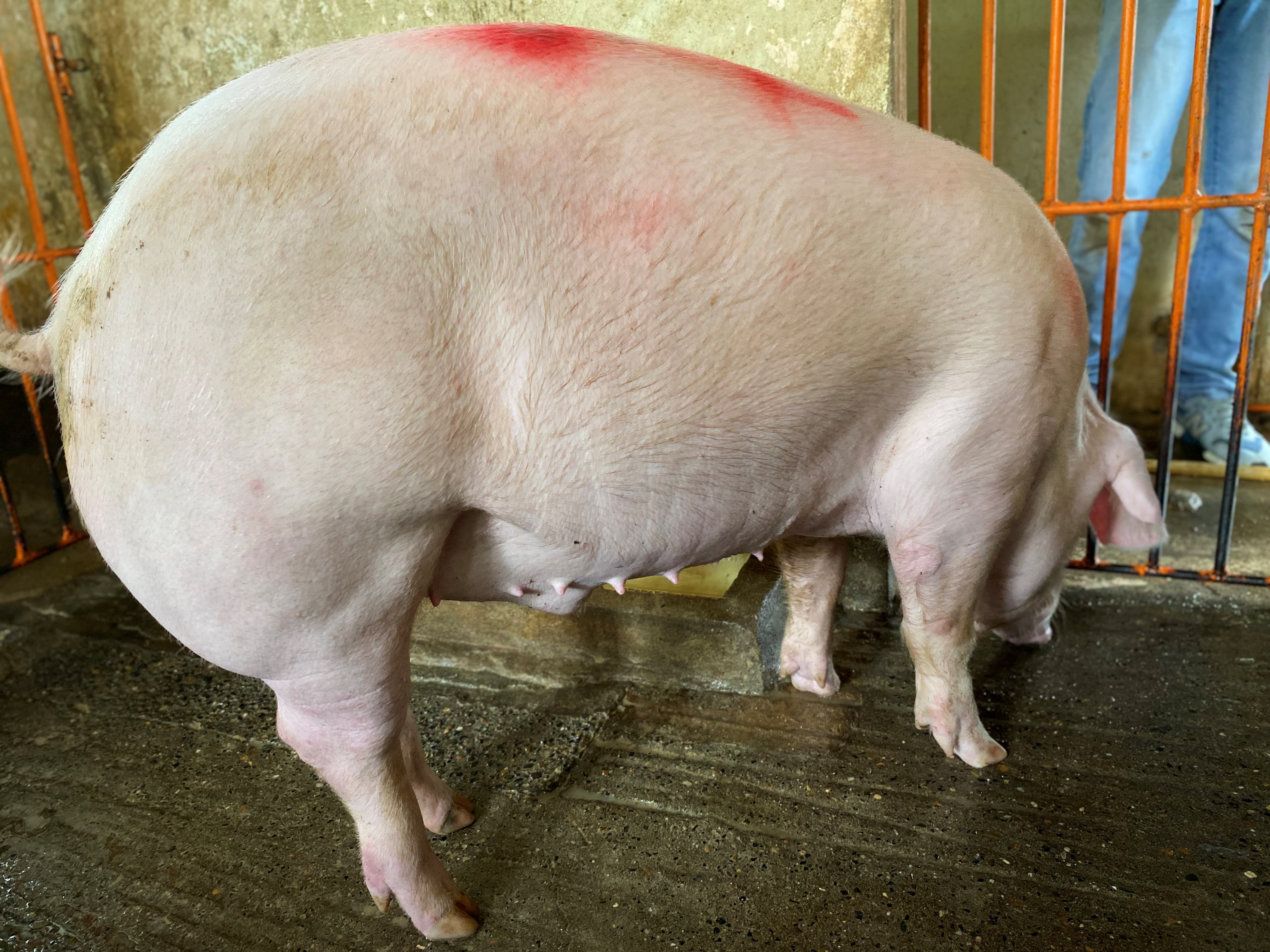Zoometry of obese pigs undergoing experimental bariatric surgery hourglass with gastro-jejunal bypass
Zoometría en cerdos obesos intervenidos con cirugía bariátrica experimental reloj de arena con derivación gastro-yeyunal

This work is licensed under a Creative Commons Attribution-NonCommercial-ShareAlike 4.0 International License.
Show authors biography
Objective. To evaluate zoometric variables in obese Landrace pigs undergoing experimental hourglass bariatric surgery with gastro-jejunal bypass (CBERADG-Y). Materials and methods. The evaluation was performed in three phases with 12 purebred animals divided into an experimental group and two control groups. Phase 1: induction of obesity reached in 120 days. Phase 2: practice of experimental surgery. Phase 3: evaluation of zoometric variables [body mass (BM), occipital-coccygeal length (L Occ-Co), abdominal diameter (AD), and body mass index (BMI)] in the experimental pigs; comparing measurements at day zero, day 15, and day 30 between groups and intra-group. Results. At the end of the study, the experimental group reduced MC, DA, and BMI without affecting L Occ-Co, while the two control groups maintained these variables stable. Conclusions. Although there were no significant differences between groups, it was possible to standardize a bariatric surgery that had a quantitative influence on the zoometric variables of the experimental group.
Article visits 91 | PDF visits
Downloads
- Stein CJ, Colditz GA. The Epidemic of Obesity. J Clin Endocrinol Metab 2004; 89(6):2522-2525. https://doi.org/10.1210/jc.2004-0288
- Okunogbe A, Nugent R, Spencer G, Powis J, Ralston J, Wilding J. Economic impacts of overweight and obesity: current and future estimates for 161 countries. BMJ Glob Health. 2022; 7(9):e009773. https://doi.org/10.1136/bmjgh-2022-009773
- Nagaya M, Hasegawa K, Uchikura A, Nakano K, Watanabe M, Umeyama K, et al. Feasibility of large experimental animal models in testing novel therapeutic strategies for diabetes. World J Diabetes 2021; 12(4):306-330. http://dx.doi.org/10.4239/wjd.v12.i4.306
- Pérez López LDC, Wägner AM. La obesidad en nuestras mascotas, un problema actual. En 30 aniversario de la ULPGC Cultura Científica. Servicio de Publicaciones, 2020.
- Pacheco Sánchez D, Pinto Fuentes P, Asensio Díaz E. Actualización en cirugía bariátrica/metabólica. Nutr Clin EN Med. 2019; 8(2):113-127. https://doi.org/10.7400/NCM.2019.13.2.5077
- Papamargaritis D, le Roux CW. Do Gut Hormones Contribute to Weight Loss and Glycaemic Outcomes after Bariatric Surgery? Nutrients 2021; 13(3):762. https://doi.org/10.3390/nu13030762
- Albaugh VL, Banan B, Ajouz H, Abumrad NN, Flynn CR. Bile acids and bariatric surgery. Mol Aspects Med. 2017; 56:75-89. https://doi.org/10.1016/j.mam.2017.04.001
- Khan S, Rock K, Baskara A, Qu W, Nazzal M, Ortiz J. Trends in bariatric surgery from 2008 to 2012. Am J Surg. 2016; 211(6):1041-1046. https://doi.org/10.1016/j.amjsurg.2015.10.012
- McCarty TR, Echouffo-Tcheugui JB, Lange A, Haque L, Njei B. Impact of bariatric surgery on outcomes of patients with nonalcoholic fatty liver disease: a nationwide inpatient sample analysis, 2004–2012. Surg Obes Relat Dis. 2018; 14(1):74-80. https://doi.org/10.1016/j.soard.2017.09.511
- Khorgami Z, Shoar S, Andalib A, Aminian A, Brethauer SA, Schauer PR. Trends in utilization of bariatric surgery, 2010-2014: sleeve gastrectomy dominates. Surg Obes Relat Dis. 2017; 13(5):774-778. https://doi.org/10.1016/j.soard.2017.01.031
- Hernández Hurtado L, Sánchez-Margallo FM, De la Cruz Vigo JL, Maestre Antequera J, Matos Azevedo AM, Casado JG, et al. Changes on Adipose Tissue Distribution After Laparoscopic Roux-en-Y Gastric Bypass in Obese Göttingen Minipig. Effects on Glucose Metabolism. Obes Surg.2016;26(12):3001-6. http://link.springer.com/10.1007/s11695-016-2223-z
- Curtasu MV, Skou Hedemann M, Nygaard Lærke H, Bach Knudsen KE. Obesity Development and Signs of Metabolic Abnormalities in Young Göttingen Minipigs Consuming Energy Dense Diets Varying in Carbohydrate Quality. Nutrients. 2021; 13(5):1560. https://www.mdpi.com/2072-6643/13/5/1560
- Plua W, Vásquez HA, Jarrim K. Impacto del bypass gástrico sobre el Índice masa corporal de adultos diabéticos en el primer año postquirúrgico. RECIAMUC. 2022; 6(3):612-624. https://reciamuc.com/index.php/RECIAMUC/article/view/933
- DeAntonio J, Cockrell H, Kang HS, Bean MK, Thompson N, Brengman M, et al. A pilot study of laparoscopic gastric plication in adolescent patients with severe obesity. J Pediatr Surg. 2019; 54(8):1696-1701. https://linkinghub.elsevier.com/retrieve/pii/S0022346819300119
- Benítez R, Trakooljul N, Núñez Y, Isabel B, Murani E, De Mercado E, et al. Breed, Diet, and Interaction Effects on Adipose Tissue Transcriptome in Iberian and Duroc Pigs Fed Different Energy Sources. Genes. 2019; 10(8):589. https://doi.org/10.3390/genes10080589
- Parmar CD, Mahawar KK. One Anastomosis (Mini) Gastric Bypass Is Now an Established Bariatric Procedure: a Systematic Review of 12,807 Patients. Obes Surg. 2018; 28(9):2956-2967. http://link.springer.com/10.1007/s11695-018-3382-x
- Heymsfield SB, Gonzalez MCC, Shen W, Redman L, Thomas D. Weight loss composition is one-fourth fat-free mass: a critical review and critique of this widely cited rule: Weight loss composition. Obes Rev. 2014; 15(4):310-321. https://onlinelibrary.wiley.com/doi/10.1111/obr.12143
- De La Cruz-Muñoz N, Lopez-Mitnik G, Arheart KL, Miller TL, Lipshultz SE, Messiah SE. Effectiveness of bariatric surgery in reducing weight and body mass index among Hispanic adolescents. Obes Surg. 2013; 23(2):150-156. https://doi.org/10.1007/s11695-012-0730-0
- Jang C, Hui S, Lu W, Cowan AJ, Morscher RJ, Lee G, et al. The Small Intestine Converts Dietary Fructose into Glucose and Organic Acids. Cell Metab. 2018; 27(2):351-361. https://doi.org/10.1016%2Fj.cmet.2017.12.016
- Stinson EJ, Piaggi P, Ibrahim M, Venti C, Krakoff J, Votruba SB. High Fat and Sugar Consumption During Ad Libitum Intake Predicts Weight Gain. Obesity. 2018; 26(4):689-695. https://onlinelibrary.wiley.com/doi/10.1002/oby.22124
- Lahsen MR, Kuzmanic VA. Cirugía metabólica 10 años después: una mirada desde la diabetología. Rev Médica Clínica Las Condes. 2016; 27(2):188-194. https://doi.org/10.1016/j.rmclc.2016.04.008
























